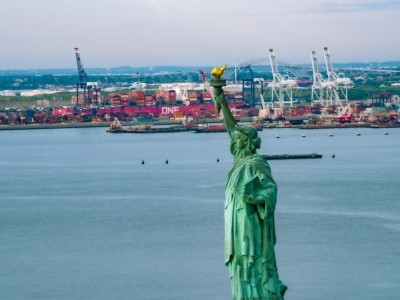AWO’s Carpenter cites Jones Act and WRDA gains in 2020 despite Covid challenges
Jennifer Carpenter, president of the American Waterways Operators (AWO) told AJOT in an interview that despite the Covid crisis, the industry benefited from a number of successes in the outgoing 116th Congress:
Passage of the Water Resources Development Act (WRDA) of 2020 “reflects an investment in our ports and waterways infrastructure and is an investment in American jobs and competitiveness.” Carpenter noted that the new legislation reduces the tug and barge industry’s share of costs for construction and major rehabilitation of inland waterways projects. The share has been changed from 50% Inland Waterways Trust Fund (IWTF)/50% General Revenues to 35% IWTF/65% General Revenues for Fiscal Years (FY) 2021 through FY 2031. The result will increase the amount of federal funding and “will help fast-track construction, maintenance and repair of our nation’s waterway projects.”
The National Defense Authorization Act (NDAA) 2020 “provided more transparency and definition to the process of obtaining waivers” for the Jones Act. The Jones Act requires that cargo transported between U.S. ports be carried by vessels, built in the United States, manned by U.S. mariners and owned by U.S. citizens. Waivers have been used to weaken enforcement of the Jones Act. During the Trump administration, waivers were sought to shift transport of waterborne freight onto foreign flag vessels on three occasions. The new language in NDAA, Carpenter says, reduces the possibility of unnecessary waiver applications and also bolsters Jones Act requirements for Department of Defense cargoes. Carpenter recently told a Congressional committee: “The Jones Act… has served our nation’s economic, homeland and national security well. It is more relevant than ever today, as both the pandemic and the prevailing geopolitical situation underscore the inadvisability of relinquishing control of our domestic maritime supply chain to foreign companies (perhaps state owned) and foreign mariners.”

The NDAA also included language to strengthen Jones Act provisions in the construction and operation of offshore wind farms in the United States. Carpenter said the new language eliminates ambiguity about the extent to which Jones Act vessels will be required. She said the clarifications in the NDAA will support growth of American mariner jobs in the construction of offshore wind farms in the United States. Critics say provisions did not go far enough to ensure Jones Act enforcement in the construction phase of wind farms, before the wind farms generate power.
Covid Impact
Carpenter admitted that the spread of the Covid virus acted as “a dimmer switch” on growth for the tug and barge industry in 2020. She does not expect a full recovery until the second half of 2021.
In response to the pandemic, the industry “made health and safety a priority” and so waterborne commerce was not seriously disrupted. This success reflected the “resilience of an industry that has faced many crises (although not a pandemic) and so for us this was not our first rodeo ride…. most mariners kept safe… companies deployed quarantine and safety provisions quickly.”
Carpenter also recognized the support given the industry by the U.S. Coast Guard.
She noted that “grain exports did very well in 2020, including to China,” but that “petroleum took a hit” due to reduced traveling by Americans responding to quarantines and stay-at-home requirements.
Diversity
Carpenter said there was progress on hiring women and mariners of color in 2020 “but the industry still has a long way to go.” She noted that companies realize that manning requirements for the future require enlarging the employee pool of mariners. Companies “recognize that diversity can help make that happen.”
Battery Power
Carpenter said that the tug and barge industry realize that shippers, policy makers and the public support a reduced carbon footprint and predicts: “I think that things will look very different five years from now.” The acquisition of batteries to shift from fossil fuel power to electric power is beginning to happen but vessel owners and operators are confronted by the challenge of “how do I recoup my investment?”
Carpenter noted that waterborne vessels have the capacity to push more barges transporting more freight on a per unit basis than locomotives and trucks. However, to maintain its low fuel consumption status, tug and barge companies must acquire more battery powered equipment “or we are going to face the prospect of losing business to electric powered trucks.”
Marine Highway
Carpenter noted that truck and highway congestion on the Atlantic coast’s I-95 corridor and on the Pacific Coast’s I-5 corridor argues for expanding the use of tug/barges and coastal shipping to carry freight by water and relieve highway gridlock. The Marine Highway initiatives advanced by the U.S. Maritime Administration, a division of the U.S. Department of Transportation, could generate more waterborne freight transportation but the obstacle has been with U.S shippers: “The shippers need to be convinced that U.S. tug/barges and U.S. coastal ships can provide a timely and cost-efficient alternative to the railroads and trucks.”
Similar Stories

Port of Seattle Statement on importance of industrial lands
View ArticleUAB-Online identifies key maritime industry trends
Stricter regulations, rapid technological advancements, and the global push for net-zero emissions are set to redefine maritime operations in Europe and the United States this year, in the viewpoint of…
View Article
Port of Los Angeles processed 10.3 million TEUs in 2024
View Article
Signal Marine Dry Weekly Market Monitor - Week 04.2025
View Article
Port Authority to outilne upcoming PATH Hoboken Station closure, detail alternate travel options
View ArticleMatson announces quarterly dividend of $0.34 per share
The Board of Directors of Matson, Inc. (NYSE: MATX), a leading U.S. carrier in the Pacific, today declared a first quarter dividend of $0.34 per common share. The dividend will…
View ArticleGet the most up-to-date trending news!
SubscribeIndustry updates and weekly newsletter direct to your inbox!





